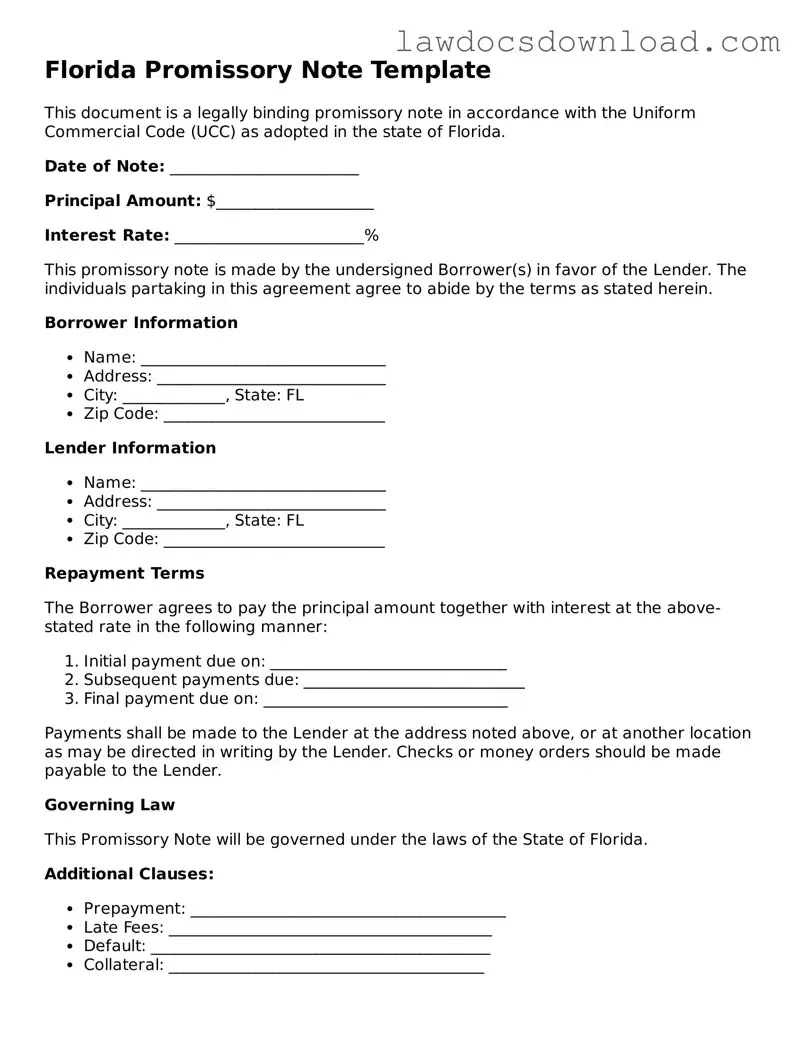One document similar to the Florida Promissory Note is the Loan Agreement. This document outlines the terms and conditions under which a loan is provided, including the repayment schedule, interest rates, and the parties involved. Like a promissory note, a loan agreement is a binding contract that obligates the borrower to repay the lender. However, it is typically more detailed, covering aspects like collateral requirements and actions in case of default.
Another related document is the Mortgage Agreement. Primarily used in real estate transactions, this agreement secures a loan by using the property as collateral. In similarity to promissory notes, it involves a pledge to pay back a debt. But, a mortgage agreement also grants the lender a lien on the property, giving them the right to seize it if the borrower fails to meet their obligations.
The IOU (I Owe You) is a simpler, less formal version of a promissory note. It acknowledges that a debt exists and generally specifies who owes who, but may not include detailed repayment terms. Unlike more formal arrangements, an IOU might lack legal enforceability in certain situations due to its informal nature and lack of details.
The Debt Settlement Agreement is a document used when a debtor and creditor agree on reducing the amount owed and setting new terms for repayment. Similar to a promissory note in its aim to settle debts, this agreement differs by often involving negotiation to adjust the original debt terms, which can include waiving certain fees or reducing the principal amount.
A Bill of Sale, while often used to document the transfer of ownership for goods or personal property, can sometimes resemble a promissory note when it includes terms for deferred payments. In those cases, it specifies what is being sold, to whom, and under what payment conditions, thereby committing the buyer to paying the seller over time for the acquired item.
The Guaranty Agreement adds a third party to the equation, where someone agrees to be responsible for a debt if the original borrower defaults. This is similar to a promissory note's purpose of ensuring repayment. However, it brings in an additional layer of security for the lender, with another individual or entity guaranteeing the loan.
Lines of Credit agreements can also have similarities to promissory notes. They allow borrowers to draw funds up to a specified limit and pay interest on the amount drawn. Similar to promissory notes, they require the borrower to repay the borrowed amount. However, they offer more flexibility, permitting multiple draws and repayments within the agreed limit.
A Revolving Credit Agreement, much like a line of credit, offers a borrower the ability to borrow, repay, and borrow again up to a certain credit limit. While it shares the promissory note's fundamental commitment to repay, it is more complex and flexible, often used by businesses for operational funding.
The Credit Agreement is another finance document similar to the promissory note, typically used in more sophisticated lending transactions. It outlines the terms under which credit is extended, including repayment conditions, interest rates, and covenants. While it serves the same primary function of documenting a loan and its repayment, credit agreements are more detailed and tailored to complex financing arrangements.
